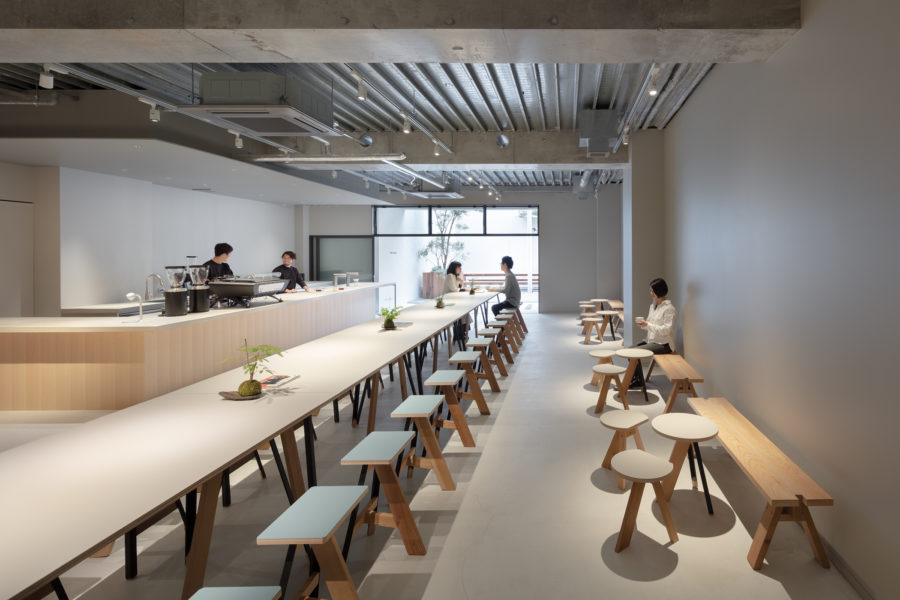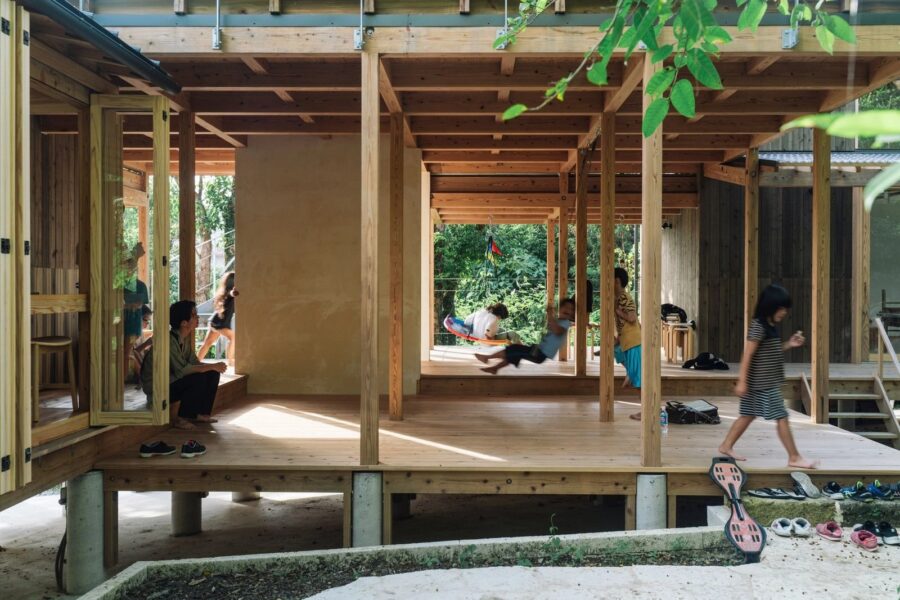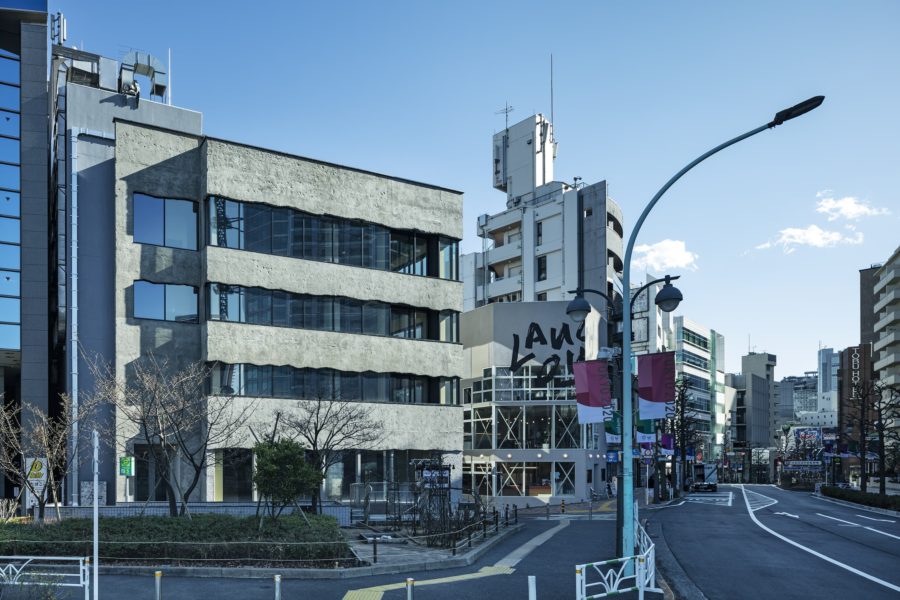沖縄県の中部、うるま市の東側、海から 500メートルほど離れた高台で東に海を望めるところに位置する。
まずこの敷地に立ったとき、海の見える素晴らしいロケーションを最大限に活かす建築を考えなければならないと考えた。そこで接道している南側への開口は最小限としながら、東側の海が見える方向へ可能なかぎり大きな開口を取り、眺望を取り込めるように計画した。どの空間からも綺麗な海が眺められるように、海側のロケーションと平行である東西方向の大きな壁を並べ、敷地手前から奥へ向かいその壁を境に、エントランスゾーン→パブリックゾーン→プライベートゾーンというかたちで壁による明確なゾーニングとするとともに、余計なものはその壁で切り取られ、邪魔するもののない綺麗な景色がどの空間からも楽しめるように考えた。
特にLDKの空間は開口を木製の大型引込み戸とすることで外部との一体化をはかり、内部から自然に外部へつながり、内か外か錯覚を起こすような開放的な空間とした。床にはあえてレベルに変化をつけ、段差による緩やかなゾーン分けを行い、またレベル差で生じる視線の変化により空間に広がりを持たせるとともに、300㎜高くしたキッチンスペースに関してはリビングを介してもよい眺望が確保できるような効果を与えた。
仕上げに関しては、内壁外壁および天井ともに普通型枠、一部にスギ板型枠を用いた打ち放し仕上げ、床には割肌の玄昌石という「粗」な仕上げとした。粗な空間とすることで、より空間自体のもつ力が引き出され、自然と対峙しながら自然と一体化できるような、普遍的で原始的な空間ができると考えた。
インテリアに関しては、無垢や質感のある素材、またアンティークの照明などを使用し、建物とのバランスを考え計画した。この住宅の中心でもあるキッチンは、多くの人が集まっても対応できるようにフラットなダイニングテーブル一体型のアイランドキッチンとし、天板は無垢の1枚板で、機器はなるべく存在感を抑えられるよう昇降式のレンジフードを使用し、色彩も統一した。
台風の多い沖縄の高台で、このような大開口をもつ住宅をつくることはとても勇気の必要なことであったが、この場所でしかできない、この場所だからこそできる建築を考えた。
このすばらしい環境で多くの台風も経験しながら年月を重ね、建築自体もこの環境とともに風景の一部となっていくことを願っている。(畠山武史)
A house that coexists with nature in a space with a rough finish
On the east side of Uruma-City, Okinawa, the site is situated on a hill that is 500m away from the ocean.
A panoramic ocean view can be seen on the east side of the site. When standing at the site, we conceived that we had to create an architecture optimizing the beautiful location overlooking the sea. To take advantage of the panoramic view, we planned to place large openings as much as possible on the east side of the house while minimizing the openings on the south side of the house connected to the road. In addition, we planned to install the long walls extended in the east-west direction in parallel with the sea, so as to overlook the sea anywhere inside of the house. By the long walls, we clearly divide the house into three spaces which are the entrance, public and private spaces. These three spaces are positioned in parallel from the front side toward the backside of the site. The extra length of the walls makes it possible to enjoy the beautiful ocean view from respective spaces while preventing any obstacle from coming into sight.
Especially in living/dining/kitchen space, we create the open space blurring the line between the inside and outside. At the openings of the space, we use the wooden frames for the windows extended from ceiling to floor. As a result, the internal space extends naturally toward the outside, and the inside and the outside are overlapped. We make a difference in level on the floor in order to roughly subdivide the space into the living, dining, and kitchen area. The difference in the visual line caused by the multilevel floor offers a variation to space. The multilevel floor makes it possible for people standing in the kitchen whose floor level is 300m higher than that of the living area to see the ocean across the living. Regarding the exposed concrete finish for the ceilings and walls, we use plywood for the most part and partially use cedar planks to mold them. On the floor, we install the Genshouseki, whose surface is chopped face and “rough” finish. We consider that the high potential of the space itself could be drawn out by applying the “rough” finish, which creates the universal and primitive space which is at one with nature while coping with nature.
Concerning the interior design, we select solid and textured materials and furniture and install antique lightings, taking the balance between the interior and the house into consideration. In the kitchen located at the center of the house, we install the island-type kitchen integrated with the dining table so as to accommodate many people. The solid-single wooden plate is used for the top of the table. The elevating type cooking range hood is installed in order to decrease the presence of the kitchen instruments. The color of the instruments is unified.
It is challenging work for an architect to build a house with large openings facing the ocean on the hill in Okinawa, where many typhoons hit. However, we designed the house, which can be realized only at the very site.
We wish that the house/building will become a part of the landscape with experiencing many typhoons over the years in such wonderful surroundings. (Takeshi Hatakeyama)
【海をのぞむ家】
所在地:沖縄県うるま市石川東恩納
用途:戸建住宅
クライアント:畠山武史
竣工:2015年
設計:クレールアーキラボ
担当:畠山武史
構造設計:建築設計庵
電気:中江電気建設
設備:ライフ工業
鉄骨工事:伊波工業所、海邦ベンダー工業
家具・建具:大城美装
キッチン:大城美装、クレールアーキラボ
サイン:エーツーサイン
施工:仲真組
撮影:井田佳明
構造:鉄筋コンクリート造
規模:地上2階建て
敷地面積:630.82m²
建築面積:222.81m²
延床面積:211.60m²
設計期間:2013.01-2014.03
施工期間:2014.04-2015.01
【House with Panoramic Ocean View】
Location: Ishikawahigashionna, Uruma-shi, Okinawa, Japan
Principal use: Residential
Client: Individual
Completion: 2015
Architects: CLAIR archi lab
Design team: Takeshi Hatakeyama
Electrical Work: Nakae Denki Kensetsu
Plumbing Work: Life Kogyo
Steel Fabricator: Iha Kogyo, Kaiho Bender Industry
Furniture / fittings: Oshiro Biso
Kitchen: Oshiro Biso, CLAIR archi lab
Sign design: A Two Sign
Contractor: Nakama gumi
Photographs: Yoshiaki Ida
Main structure: Reinforced Concrete construction
Site area: 630.82m²
Building area: 222.81m²
Total floor area: 211.60m²
Design term: 2013.01-2014.03
Construction term: 2014.04-2015.01








